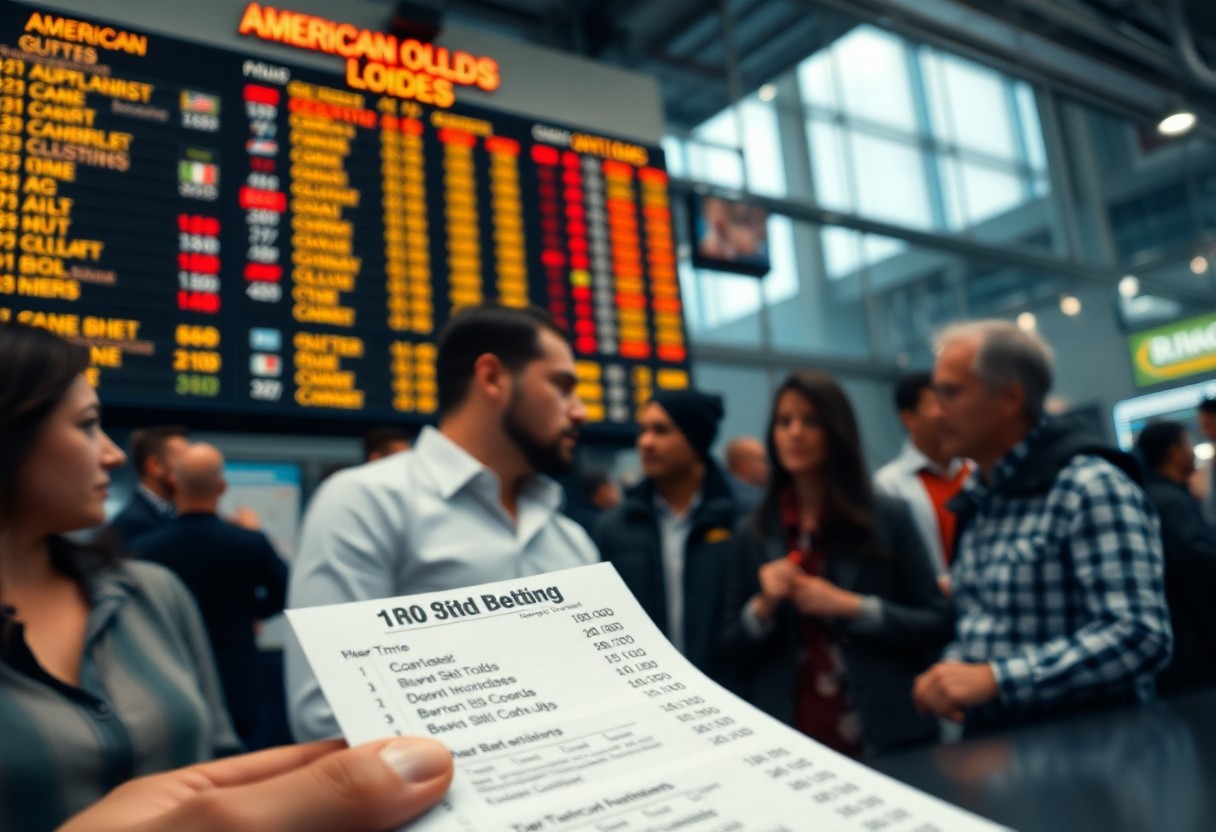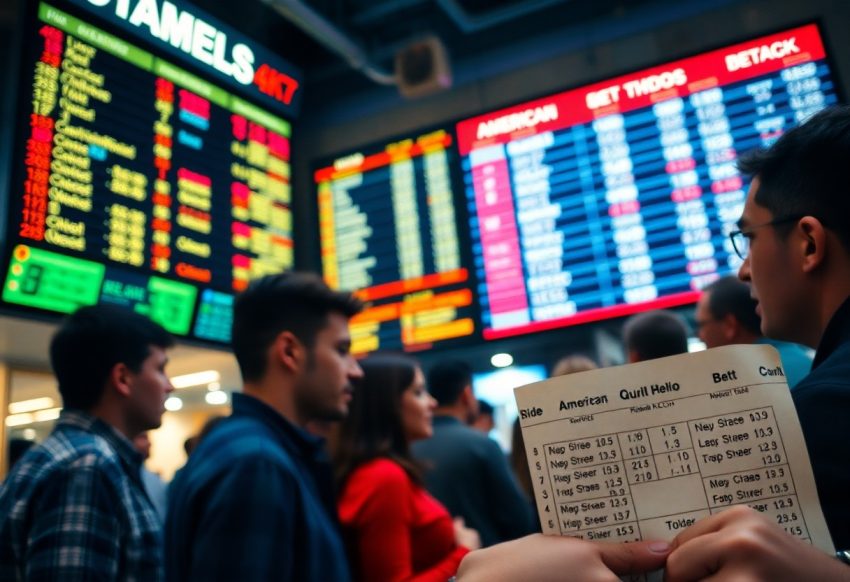American odds format is a popular betting system used primarily in the United States, and it can be quite confusing for those unfamiliar with it. You often encounter odds expressed as either positive or negative numbers, which determine potential payouts and stake amounts. Positive odds indicate the profit from a $100 bet, while negative odds show the amount one must wager to win $100. By grasping this format, bettors can enhance their decision-making and navigate the sports betting landscape with greater confidence and insight.

Key Takeaways:
- American odds are expressed as either positive (+) or negative (-) values, indicating the potential profit or amount needed to bet for a specific outcome.
- Positive odds show how much profit you can make on a $100 bet, while negative odds indicate how much you need to wager to win $100.
- Understanding the value of these odds helps in assessing risk and potential payouts in various betting scenarios.
Overview of American Odds
For anyone interested in sports betting, understanding American odds format is imperative. This format, prevalent in the United States, provides a unique way to present the odds of an event occurring. They are typically displayed as either a positive or negative number, representing potential profit or required stake, respectively. Recognizing how to read and interpret these odds is key for anyone looking to engage successfully in betting activities.
Definition of American Odds
Among the various odds formats used in betting, American odds stand out by offering a distinct method of expressing the relationship between the amount wagered and the potential payout. These odds can be either positive or negative, indicating underdog or favored status in a sporting event. By understanding this format, bettors can make more informed decisions.
Key Characteristics
Above all, American odds are characterized by their unique presentation, indicating both the risk and reward associated with a bet. Positive odds, such as +150, represent the profit from a $100 bet, while negative odds, such as -200, indicate the amount that must be wagered to win $100. This duality allows bettors to gauge the potential returns and their required investment easily.
Further, American odds provide a clear insight into the likelihood of an event occurring based on implied probabilities. Positive odds denote underdogs where the potential payout is higher, suggesting a lower probability of winning. Conversely, negative odds represent the favorites, indicating a higher probability of success but requiring a larger investment for a smaller profit. By interpreting these odds correctly, you can assess the risks and make informed betting choices.
Positive and Negative American Odds
Even though many bettors may feel overwhelmed by American odds, understanding the distinction between positive and negative odds can simplify the betting experience. Positive odds represent the potential profit on a $100 wager, while negative odds indicate how much needs to be wagered to win $100. This fundamental difference is key to interpreting odds correctly.
Understanding Positive Odds
At positive odds, bettors can expect a return that exceeds their initial stake. For example, odds of +200 suggest that betting $100 would yield a $200 profit if successful, making it easier for them to grasp potential winnings.
Understanding Negative Odds
Understanding negative odds involves recognizing that these odds reflect the amount of money necessary to win a set profit. For instance, odds of -150 indicate that a bettor must wager $150 to earn a $100 profit.
Odds of -150 signify a favored outcome, indicating that the risk is balanced by the lower potential return. The lower the negative odds, the greater the likelihood the outcome is expected. This helps bettors assess the risk versus reward aspect of their betting strategy effectively.
Converting American Odds to Other Formats
Not all bettors are familiar with American odds. Therefore, understanding how to convert these odds to different formats, such as decimal and fractional odds, is important for making informed betting decisions. By mastering these conversions, one can easily grasp the potential payouts and helps them compare odds more effectively.
Decimal Odds Conversion
Beside American odds format, one of the most popular formats is decimal odds. To convert American odds to decimal odds, bettors add 1 to the quotient of positive American odds divided by 100. For negative American odds, the conversion entails dividing 100 by the absolute value of the odds and adding 1. This allows for quick insights into the overall payout.
Fractional Odds Conversion
Converting American odds to fractional odds follows a different approach. Positive American odds translate to a fraction where the numerator represents the potential profit from a $100 stake and the denominator indicates the stake. Conversely, negative American odds convert to fractions where the numerator reflects the stake necessary to profit $100, with the denominator being $100.
Consequently, understanding the nuances of fractional odds conversion aids bettors in recognizing profitability. Accurate conversion empowers informed decisions and enhances one’s overall betting experience. This understanding is important, as it solidifies a bettor’s grasp of potential outcomes and further aids in strategizing bets effectively. Through careful attention to detail, they can maximize their odds and ensure they are making the best possible wagers.
Calculating Potential Payouts
Once again, understanding the calculation of potential payouts using American odds is imperative for bettors. When one encounters positive odds, you can determine the profit by dividing the odds by 100 and then multiplying by the stake. Conversely, for negative odds, one can calculate the profit by dividing 100 by the odds and then multiplying by the stake. This straightforward approach allows them to easily decipher potential gains.
Example Scenarios
Below are two examples showcasing the calculation of payouts. For a bet of $100 at +150 odds, the potential payout is $150, while for a wager of $100 at -200 odds, the profit amounts to $50. These simple calculations demonstrate how American odds can be utilized effectively.
Common Mistakes to Avoid
After they grasp the basics of American odds, novice bettors often make key mistakes in understanding payouts. One common error involves confusing positive and negative odds, leading to incorrect calculations of potential profits. Additionally, some may neglect to consider their initial stake, impacting their perceived winnings.
In addition to confusing positive and negative odds, you might overlook the significance of different stakes. Frequently, bettors will estimate their payouts without factoring in the stake amount, resulting in inflated expectations. Furthermore, they may rely too heavily on intuition rather than performing necessary calculations. This oversight can lead to significant losses. You should always ensure they are accurate in their calculations to guarantee realistic profit expectations. Understanding these pitfalls can improve their betting strategy and help prevent unnecessary errors.
Strategies for Betting Using American Odds
All successful bettors understand the importance of employing effective strategies when dealing with American odds. Using a structured approach can help them maximize their potential returns and manage risks effectively. By applying the right techniques and maintaining discipline, they can enhance their overall betting experience and profitability.
Bankroll Management
With effective bankroll management, bettors can sustain their betting activities over the long term. It involves setting aside a specific amount of money, known as the bankroll, dedicated solely to betting purposes. They should determine their wager size based on their overall bankroll and avoid chasing losses, ensuring they remain composed during losing streaks.
Value Betting Techniques
Between various betting strategies, value betting techniques stand out as a popular choice among seasoned bettors. This method focuses on identifying instances where the bookmaker’s odds offer a higher probability of winning than what is reflected in the odds themselves. By spotting value bets, they can increase their chances of profitability significantly.
American odds are instrumental in value betting, as they provide an easy way to assess potential payouts compared to implied probabilities. By understanding the discrepancy between the actual probability of an event occurring and the odds offered by the bookmaker, they can find lucrative opportunities. Successful value betting involves rigorous analysis and the ability to spot favorable betting opportunities. Moreover, they should always strive to keep their emotions in check and focus on data-driven insights, which can lead to sustainable profit over time.
Common Misconceptions About American Odds
To effectively grasp American odds, he must address prevalent misconceptions that can lead to confusion. Many assume that a positive number always indicates a favorite, while a negative number signifies an underdog, but this logic often oversimplifies the complexities of betting lines. Additionally, some people mistakenly believe that American odds can only indicate profit margins, ignoring their implications in relation to risk and stake amounts.
Misinterpretations
To recognize the inaccuracies surrounding American odds, one should understand that the method of calculation can distort perceptions of value and risk. Individuals might equate higher odds with a better chance of winning, failing to see that they merely reflect potential profit and not probability.
Clarifications
An necessary aspect of American odds is understanding their foundational purpose in betting. The odds reflect the bookmaker’s assessment of a team’s chances of winning versus the potential payout for successful bets, allowing for informed wagering decisions.
The American odds format can often be misinterpreted, yet it serves a vital role in sports betting. He should note that when he sees odds of +200, it indicates a potential profit of $200 on a $100 bet, whereas -150 means a bettor must wager $150 to win $100. This indicates both risk and potential reward, rather than simply the likelihood of success. By understanding these terms, you can better make informed decisions and navigate the betting landscape with more confidence.
Summing up
Drawing together the crucial aspects of American odds format, one can see how it simplifies the betting landscape for players. They provide clear insight into potential winnings and the implied probability of events. By grasping how to interpret positive and negative odds, you can make informed betting decisions that enhance their overall gaming experience. Ultimately, understanding American odds equips individuals with the knowledge they need to navigate the betting world more effectively.

